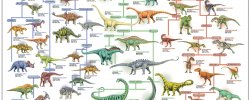Blunt Dinosaurs
 The "human lizards" feeding topic was always relevant. One of the hottest questions for decades is the number of dinosaurs in the diet. In the article, we will review it against the current data. We'll also touch other nutritional features.
The "human lizards" feeding topic was always relevant. One of the hottest questions for decades is the number of dinosaurs in the diet. In the article, we will review it against the current data. We'll also touch other nutritional features.
Before we begin our analysis, we will adopt the basic definitions.
Hard - these are creatures that predominantly eat (more than 50 per cent) meat and other animal food.
Passenger, paleed, cadaver or necrofag - a creature predominantly (more than 50 per cent) of animal remains, and the latter are not the result of their own or joint hunting.
We now propose a declassification on this basis. Let's stress that it can be used not only in the dinosaur system, but also for any animal in general.
 Classification of damsel animals by number fell in the diet
Classification of damsel animals by number fell in the diet
| Name of category | Interest falling |
| Intensive scavenger | 80% |
| Active scavenger | 70% to 80% inclusive |
| Universal scavenger | 60% to 70% inclusive |
| Mixed ranger | 50 per cent to 60 per cent inclusive |
| Mixed predator | 40% to 50% inclusive |
| Universal predator |  30 per cent to 40 per cent inclusive 30 per cent to 40 per cent inclusive |
| Active predator | 20 per cent to 30 per cent inclusive |
| Intensive predator | up to 20% inclusive |
Dinosaur models for each category are further proposed for the set of criteria. The analysis was based on the building of jaws, one of the most important instruments of damaging dinosaurs. The overall structure of the body and habitat is also taken into account.
DiNozzars above average
First of all, we'll look at the relatively large dinosaurs (about 7 metres long). The group differs from the fact that there are no classic fallers on all grounds. Rationale: Modern terrestrial ecosystems do not have damsel animals above average sizes, which are clearly expressed as fallers. Traditionally, fallers are mostly small animals (e.g. some insects) or mobile averages (e.g. some birds).The first type is characterized by very low food requests. The second type is characterized by small requests combined with high speeds of movement and developed senses. In a global sense, the structure of meso-ozone ecosystems is not different from modern ones, so this argument is quite applicable.
Mixed predators
The first is the Indian Rajazaur on all grounds. Below the skull from the Punjab University collection (Ms. Chandigarh, India).












